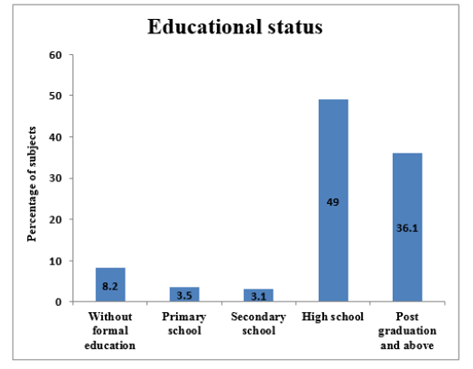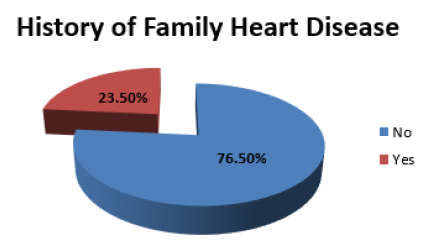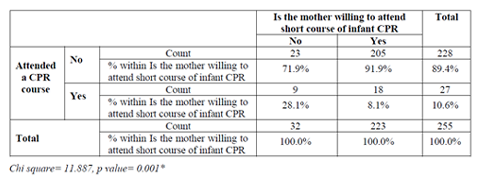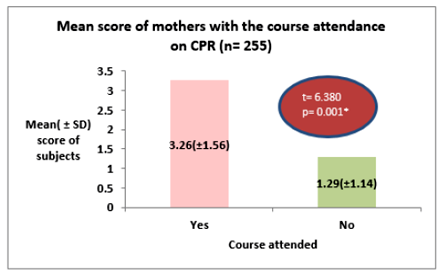Information
Journal Policies
The Knowledge of Infant CPR among Mothers in King Abdulaziz Medical City (KAMC)
Farhan Alenezi1, Sreekanth Komath Mohan1, Rayan Mohammed Almutairi1, Hatim Abdulrahman Altheyab1, Abdulmajeed Alkhaldi1, Bassam Mohammed Alanazi1, Rayan Mohammed Alay1, Winnie Philip2, Shoeb Qureshi2*
2.Research Department, College of Applied Medical Sciences, King Saud Bin Abdul-Aziz University for Health Sciences, Riyadh, Saudi Arabia.
Copyright :© 2018 Authors. This is an open-access article distributed under the terms of the Creative Commons Attribution License, which permits unrestricted use, distribution, and reproduction in any medium, provided the original author and source are credited.
Introduction: Cardiac arrest is characterized by an inability of the heart to function which leads to loss of breathing and consciousness. The incidence of cardiac arrest is more common in infants while compare to other pediatric age groups. Since there is an increase in mortality rate in infant cardiac arrest, early identification of the pre-arrest scenario and its management is crucial. Hence, the present study is to study the knowledge of infant CPR among mothers with an infant and their willingness to learn infant CPR in KAMC.
Objectives: To compare the awareness and knowledge of infant CPR among the educated and non-educated mothers and evaluate the willingness of mothers to learn CPR, especially infants CPR and to identify the reason for unawareness of infant CPR in them.
Methodology: The study was conducted in department of Pediatrics, Obstetrics and Gynecology in KAMC. The subjects included were all women who had an infant in KAMC. The study was a quantitative, cross- sectional prospective study design. Data was collected using suitably structured questionnaire and entered in Microsoft Excel sheets and subsequently uploaded and analyzed in SPSS software version 22.
Results: The total number of females participated in this study was 255(n=255) with a mean age of 30 years old. Out of the total subjects participated in this study, 230 had poor knowledge about infant’s CPR while comparing to 25, 9.8% had good knowledge. Even though 228 (89.4%) out of 255 mothers did not attend the CPR, majority (89.91%) of them wanted to attend or were willing to attend the course.
Conclusion: Although there was a high level of motivation to attend infant CPR course among mothers. Mothers' level of knowledge about infant CPR was inadequate, among the educated mothers in KAMC. As a result, we suggest that there must be infant CPR courses given to mothers in the KAMC.
1. Introduction
The infant CPR becomes lifesaving since the incidence of cardiac arrest is more common in infants while compare to other pediatric age groups. A recent study conducted in pediatric OHCA showed a survival rate between 4.3 % to 9.0 %. It has shown that 1.8% - 5% of patient who died with trauma could be survived if bystanders provided bleeding control and airway clearance. Therefore it is important to evaluate the level of knowledge of infant CPR. This study was conducted to evaluate the level of knowledge of infant CPR among mothers in King Abdulaziz Medical City in Riyadh.
2. Review of Literature
Cardiac arrest is a condition characterized by a sudden inability of the heart to transfer blood to the body which leads to loss of breathing and consciousness. The incidence of cardiac arrest is more common in infants while compare to other pediatric age groups [1]. The optimal duration of pre-hospital cardio-pulmonary resuscitation for out of hospital cardiac arrest is 35-48 minutes. Therefore the chances of survival will fall to less than 1% [2] The high quality CPR is important for survival and improvement of neurological outcome following cardiac arrest [3]. Even though the survival outcome of pediatric CPR have improved over last 20 years, the survival with good neurologic outcome is still low (17% after in-hospital cardiac arrest, 2% after out-of-hospital arrest) [4]. In children 3.73 per 100,000 person get cardiopulmonary arrest (CPA); 6.37 per 100,000 person in adolescents while 72.7 per 100,000 person in infant [1]. An increased variation in incidence and outcome of out-of-hospital cardiac arrest (OHCA) has been reported worldwide [5]. In 2013, King Khalid University Hospital did a study about out-of- hospital cardiac arrest in 96 adult patients. The study concluded 100% mortality rate among traumatic OHCA patients and a low rate of survival for non-traumatic patients [6]. A recent study conducted in pediatric OHCA showed a survival rate between 4.3 % to 9.0 % [7,9]. It has shown that 1.8% - 5% of patient who died with trauma could be survived if bystanders provided bleeding control and airway clearance [10]. Another study conducted in 753 subjects in the community of the Al- Khobar city about awareness and knowledge of pediatric CPR revealed that 365 female subjects and 247 male subjects failed to perform chest compression and rescue breaths [11]. The training in infant CPR especially to the parents should be given prime importance since a report in 2005 has shown the expiry of 2230 infants younger than 1 year with sudden infant death syndrome which made it the third leading cause of death in infants [12]. A similar study conducted by Dammam University Hospital in April 2013 about the awareness and knowledge of pediatric cardio-pulmonary resuscitation in the community of Al-Khobar city also concluded an inadequate public awareness and knowledge of CPR [13]. According to American Heart Association, CPR performed especially in the first few minutes of OHCA that mostly happen in the home, can increase a person’s chance of survival to 70% [14]. The American Heart Association teaches cardiopulmonary resuscitation (CPR) to more than 9 million people yearly [15]. Parents considered CPR as a priority when they were asked to rank teaching topics at the time of discharge due to its importance [16]. Others have found that CPR classes instruct parents as well as enhance their self-confidence [17]. Despite all these reasons to learn CPR, however, a lot of barriers prevent its widespread dissemination [18]. Unfortunately, nearly about 46% of people who experience an out-of-hospital cardiac arrest (OHCA) cannot get an immediate help that they need before professional help arrives [19]. Every minute lost in starting CPR leads to 10% reduction in survival rates of the victim [20].
Since there is an increase in mortality rate in infant cardiac arrest, early identification of the pre arrest scenario & its management is very important. So the aim of this study is to see the knowledge of infant CPR among mothers with an infant & their willingness to learn infant CPR in KAMC.
3. Materials and Methods
To evaluate the knowledge of infant’s CPR among mothers.
We conducted our research based on a suitable structured questionnaire distributed to mothers in the department of pediatrics, Obstetrics and Gynecology in King Abdulaziz Medical City (KAMC). The Data such as the age of the mother, her education level, number of children, her family history, knowledge about infant’s CPR etc., were collected. The results were analyzed using statistical methods. The study design was quantitative, cross-sectional prospective study.
The sample size was 255 mothers of KAMC. Inclusion criteria included all women who bears or have an infant in King Abdulaziz Medical City and who are willing to provide signed informed consent. Those women who are not bearing or do not have an infant and who are not willing to provide signed informed consent were excluded from the study.
The Data entered in Microsoft Excel sheets, and statistical analysis of the variables carried out by using SPSS software version 22. The categorical variable expressed as frequencies and percentages. Mean and SD were used for continuous variable.
3. Results
The total number of females participated in this study was 255(n=255). The participated women had an infant or were pregnant. The minimum age of the subjects were 17 years old and the maximum age was 47 years old with a mean age of 30 years old. The educational status of the women were diverse. Out of the total population, 49% which is (n=125) had high school education, 36% (n=92) had post- graduation and above, 8.2% (n=21) were without formal education, 3.5% (n=9) had primary school education and 3.1% (n=8) were educations until secondary school (figure:1). At the time of data collection,184 subjects (n=184) (72%) were not pregnant but had neonates or infants while 71 (n=71) (27.8%) were pregnant.
60 (n=60) (23.5%) of the women had a family history of heart disease before enrolling this study whereas 195 (n=195) (76.5%) did not had a family history of heart disease (figure:2).The subjects (n=27) or (10.6%) had attended a course on cardiopulmonary resuscitation (CPR) and those in attendees 14 (n=14) which is (51.9%) attended the CPR program only once while 6 (n=6) which is (22.2%) attended the CPR twice and 7 (n=7),(25.9%) attended the CPR course more than twice. 228 (89.4%) had either no knowledge or had not attended or heard about CPR so far.
Out of the total subject participated in this study, 230 (n=230) which constitute (90.2%) had poor knowledge about infant’s CPR while comparing to 25 (n=25), which adds small population (9.8%) had good knowledge.
The above table 1 illustrates mother’s willingness to attend the CPR course. 27 (10.6%) have already attended the CPR course. Even though 228 (89.4%) out of 255 mothers did not attend the CPR, so far, majority (n=205), (89.91%) of them wanted to attend or were willing to attend the course. This is also statistically significant with a p value (p: 0.001) (table: 2). The mean knowledge score of mothers about CPR is 1.49 with a standard deviation (sd: ±1.337) with a maximum score of 6.
A comparison was done with knowledge of subjects with some of the variables like education, number of children and age of fetus or younger child. It was found that the knowledge of those subjects with schooling or under graduates (n=163) with a mean (1.33) and subjects with post-graduation and above (n=92) with a mean (1.79) was statistically significant with a standard deviation (sd: 1.29), (sd: 1.38) respectively with a p value (p: 0.007) (table: 3). Comparison with other variables like number of children and age of children with knowledge were not significant statistically. A family history of heart disease and the subject’s knowledge was also assessed and found no significance in this aspect.
The subjects (n=27) had attended a course on cardiopulmonary resuscitation (CPR) and it was found that those subjects who attended the CPR course (mean score of 3.26, sd: ±1.56) had a better knowledge about infant CPR than those subjects who didn’t attend CPR course (mean score 1.29, sd: ± 1.14) which showed statistical significance (p:0.001) (figure:3). But this study didn’t show any statistical significance among the subjects who attended the CPR course only once and more than one time.
5. Discussion
Even though out-of-hospital cardiopulmonary arrest in children is rare, it is significant because of its poor survival rates and high morbidity. In the light of this evidence, this study shows that out of 255 participants, 230 (90.2%) of mothers has poor knowledge regarding infant CPR. It is found that as the educational level goes high (non educated-high school-undergraduates –post graduates respectively) participants’ knowledge about infant CPR is also high. The study also reveals that even though a very few subjects attended CPR training before; the majority of them were willing to attend a short CPR course.
Our findings that majority of mothers who visited King Abdul-Aziz Medical City have poor knowledge of infant CPR replicates the finding of a cross sectional community-based survey conducted by Hatim K. Al-Turkistani et al .However the willingness to attend a short infant CPR course was more in subjects who visited King Abdul-Aziz Medical City (89.91%) than that of the cross sectional study conducted in Dammam University Hospital in April 2013(59.4%) by Hatim K. Al-Turkistani et al. This study finds a high knowledge level in subjects who were already trained in infant BLS which favors a questionnaire survey conducted by Patricia Ching Yen Chia and her colleagues in their study also found a higher knowledge in the trained subjects while compare to the untrained subjects. The perceptions to attend a CPR course among the mothers in this study are very similar to the perception of those new mothers who considered learning CPR as very important in a prospective, cohort study conducted by Gavin C. Barr, Jr., MD et al.
According to our knowledge this study is the first study to evaluate the knowledge of infant CPR among mothers in the kingdom of Saudi Arabia. According to American Heart Association, CPR performed especially in the first few minutes of out of hospital cardiac arrest (OHCA) that mostly happen in the home, can increase a person’s chance of survival to 70%. Every minute lost in starting CPR leads to 10% reduction in survival rates of the victim. This study shows the need of effective training in infant CPR since most of the infants will be always with their mothers or mother can be considered as the first responder in most of the times. Hence providing an effective training on cardiopulmonary resuscitation to especially to those mothers having an infant or infants can increase the infant chance of survival.
6. Conclusion
Although there was a high level of motivation to attend infant CPR course among mothers, Mothers' level of knowledge about infant CPR was inadequate, even among the educated mothers in King Abdul-Aziz Medical City. As a result, we suggest that there must be a pulsed infant CPR courses given to mothers in the King Abdul-Aziz Medical City and also to develop an awareness regarding the importance of infant CPR in all the hospitals and health care sectors where they have prenatal care and screening facilities or the place having the department of Obstetrics & Gynecology as well as department of Neonatology and Pediatrics.
References
- Patricia Ching Yen Chia, Wee Bin Lian. Parental knowledge,attitudes and perceptions regarding infant basic life support. 2014, 55(3): 137–145.
- Masahiro Kashiura, Yuichi Hamabe, Akiko Akashi, Atsushi Sakurai, Yoshio Tahara, Naohiro Yonemoto, Ken Nagao, Arino Yaguchi, Naoto Morimura. Association between cardiopulmonary resuscitation duration and one-month neurological outcomes for out-of-hospital cardiac arrest: a prospective cohort study. BMC Anersthesiol. 2017;17(1):59
- Dana E. Niles, Akira Nishisaki, Robert M. Sutton, Jon Nysaether, Joar Eilevstjønn, Jessica Leffelman, Matthew R. Maltese, Kristy B. Arbogast, Benjamin S. Abella, Mark A. Helfaer, Robert A. Berg, Vinay M. Nadkarni. Comparison of relative and actual chest compression depths during cardiac arrest in children, adolescents, and young adults. 2012; 83(3):320-326
- Robert M. Sutton, Dana Niles, Peter A. Meaney, Richard Aplenc, Benjamin French, Benjamin S. Abella, Evelyn L. Lengetti, RobertA. Berg, Mark A. Helfaer, Vinay Nadkarni. Low-Dose, High-Frequency CPR Training Improves Skill Retention of In-Hospital Pediatric Providers. 2011; 128(1):145-51.
- Berdowski J, Berg RA, Tijssen JG, Koster RW. Global incidences of out-of-hospital cardiac arrest and survival rates: Systematic review of 67 prospective studies. Resuscitation. 2010; 81:1479–1487.
- Bin Salleeh HM1, Gabralla KA, Leggio WJ, Al Aseri ZA.. Out-of-hospital adult cardiac arrests in a university hospital in central SaudiArabia.2015 Sep; 36(9):1071-5.
- Deasy C, Bernard SA, Cameron P, Jaison A, Smith K, Harriss L, et al. Epidemiology of paediatric out-of-hospital cardiac arrest in Melbourne, Australia. Resuscitation. 2010; 81:1095–100.
- Bardai A, Berdowski J, van der Werf C, Blom MT, Ceelen M, van Langen IM, et al. Incidence, causes, and outcomes of out-of- hospital cardiac arrest in children. A comprehensive, prospective, population-based study in the Netherlands. J Am Coll Cardiol. 2011; 57:1822–8.
- Akahane M, Tanabe S, Ogawa T, Koike S, Horiguchi H, Yasunaga H, et al. Characteristics and outcomes of pediatric out-of-hospital cardiac arrest by scholastic age category. Pediatr Crit Care Med. 2013; 14:130–6.
- Tannvik TD, Bakke HK, Wisborg T. A systematic literature review on first aid provided by laypeople to trauma victims. Acta Anaesthesiol Scand. 2012; 56:1222–7
- Al-Turkistani HK. Awareness and knowledge of pediatric cardio- pulmonary resuscitation in the community of Al-Khobar city. Journal of family & community medicine. 2014; 21(2):125-9.
- Kung HC, Hoyert DL, Xu J, Murphy SL. Deaths: final data for 2005. Natl. Vital. Stat Rep. 2008; 56(10):1-124.
- Hatim K. Al-Turkistani. Awareness and knowledge of pediatric cardio-pulmonary resuscitation in the community of Al-Khobar city. 2014; 21(2): 125–129.
- AHAECC/CPRAndECC/AboutCPRFirstAid/C PRFactsAndStats/UCM_475748_CPR-Facts- and-Stats.jsp http://cpr.heart.org/
- 2005 American Heart Association guidelines for cardiopulmonary resuscitation and emergency cardiovascular care, part 3: overview of CPR. Circulation. 2005; 112(24 suppl): IV-12-IV-18.
- Schlessel JS, Rappa H, Lesser M, Pogge D, Ennis R, Mandel L. CPR knowledge, self- efficacy, and anticipated anxiety as functions of infant/child CPR training. Ann Emerg Med. 1995; 25(5):618-624.
- Donaher-Wagner BM, Braun DH. Infant cardiopulmonary resuscitation for expectant and new parents. Am J Matern Child Nurs.1992; 17(1):27-28.
- Braslow A, Brennan RT, Newman MM, Bircher NG, Batcheller AM, Kaye W. CPR training without an instructor: development and evaluation of a video self-instructional system for effective performance of cardiopulmonary resuscitation. Resuscitation. 1997; 34(3):207- 220.
- Graham Nichol, Elizabeth Thomas, Clifton W. Callaway. Regional Variation in Out-of- Hospital Cardiac Arrest Incidence and Outcome. JAMA. 2008; 300(12):1423-1431.
- Go AS, Mozaffarian D, Roger VL, Benjamin EJ, Berry JD, Borden WB, et al. on behalf of the American Heart Association Statistics Committee and Stroke Statistics Subcommittee, author. Heart Disease and Stroke statistics-2013 update: a report from the American Heart Association. Circulation. 2013; 127:e6–e245.










